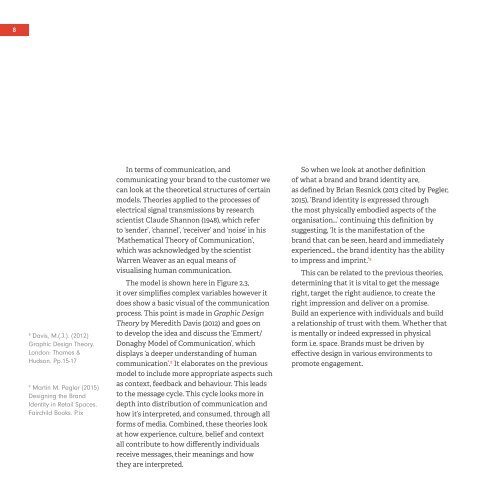Brand—Space
The impact of branding on physical space and the importance of creating an experience. Branded space, in the form of shops, museums, cafés and restaurants have an effect on us everyday. This study will look at the impact of physical space – how it can influence us and how it shapes our perceptions of brands and places. Including case studies from around the world and interviews with industry professionals.
The impact of branding on physical space and the importance of creating an experience. Branded space, in the form of shops, museums, cafés and restaurants have an effect on us everyday. This study will look at the impact of physical space – how it can influence us and how it shapes our perceptions of brands and places. Including case studies from around the world and interviews with industry professionals.
You also want an ePaper? Increase the reach of your titles
YUMPU automatically turns print PDFs into web optimized ePapers that Google loves.
8<br />
8<br />
Davis, M.(.J.). (2012)<br />
Graphic Design Theory.<br />
London: Thames &<br />
Hudson. Pp.15-17<br />
9<br />
Martin M. Pegler (2015)<br />
Designing the Brand<br />
Identity in Retail Spaces.<br />
Fairchild Books. P.ix<br />
In terms of communication, and<br />
communicating your brand to the customer we<br />
can look at the theoretical structures of certain<br />
models. Theories applied to the processes of<br />
electrical signal transmissions by research<br />
scientist Claude Shannon (1948), which refer<br />
to ‘sender’, ‘channel’, ‘receiver’ and ‘noise’ in his<br />
‘Mathematical Theory of Communication’,<br />
which was acknowledged by the scientist<br />
Warren Weaver as an equal means of<br />
visualising human communication.<br />
The model is shown here in Figure 2.3,<br />
it over simplifies complex variables however it<br />
does show a basic visual of the communication<br />
process. This point is made in Graphic Design<br />
Theory by Meredith Davis (2012) and goes on<br />
to develop the idea and discuss the ‘Emmert/<br />
Donaghy Model of Communication’, which<br />
displays ‘a deeper understanding of human<br />
communication’. 8 It elaborates on the previous<br />
model to include more appropriate aspects such<br />
as context, feedback and behaviour. This leads<br />
to the message cycle. This cycle looks more in<br />
depth into distribution of communication and<br />
how it’s interpreted, and consumed, through all<br />
forms of media. Combined, these theories look<br />
at how experience, culture, belief and context<br />
all contribute to how differently individuals<br />
receive messages, their meanings and how<br />
they are interpreted.<br />
So when we look at another definition<br />
of what a brand and brand identity are,<br />
as defined by Brian Resnick (2013 cited by Pegler,<br />
2015), ‘Brand identity is expressed through<br />
the most physically embodied aspects of the<br />
organisation…’ continuing this definition by<br />
suggesting, ‘It is the manifestation of the<br />
brand that can be seen, heard and immediately<br />
experienced… the brand identity has the ability<br />
to impress and imprint.’ 9<br />
This can be related to the previous theories,<br />
determining that it is vital to get the message<br />
right, target the right audience, to create the<br />
right impression and deliver on a promise.<br />
Build an experience with individuals and build<br />
a relationship of trust with them. Whether that<br />
is mentally or indeed expressed in physical<br />
form i.e. space. Brands must be driven by<br />
effective design in various environments to<br />
promote engagement.


